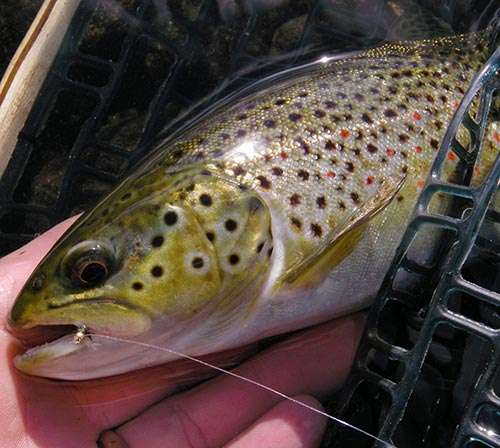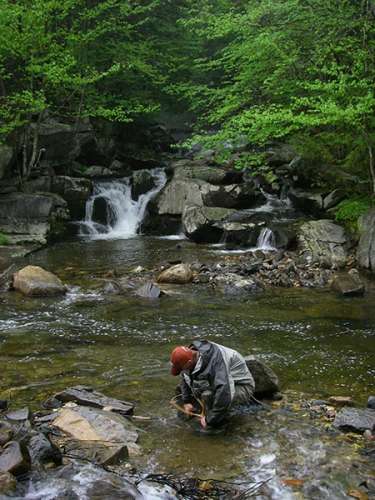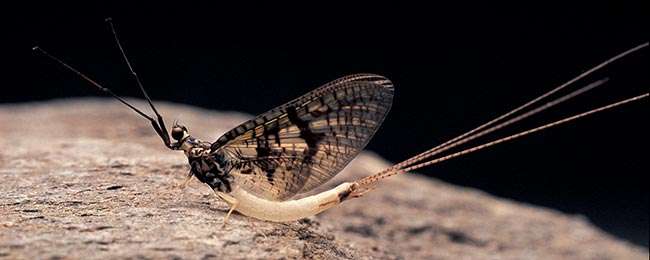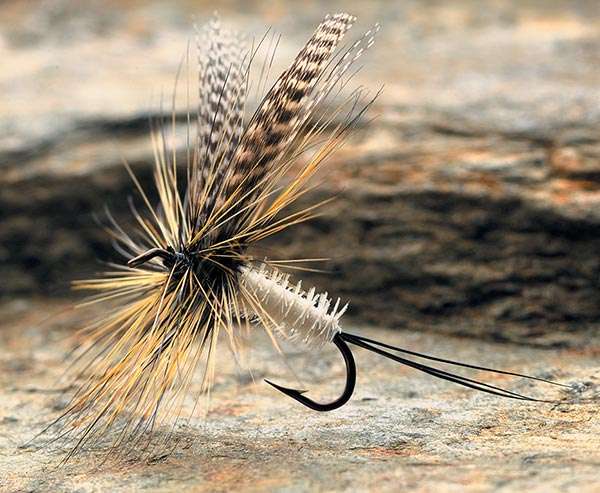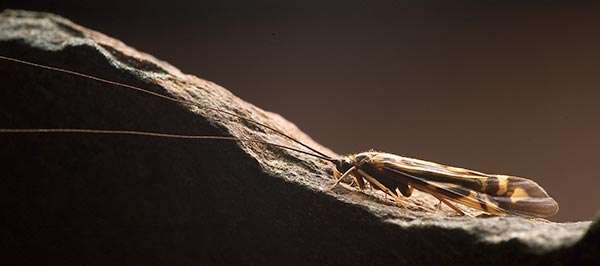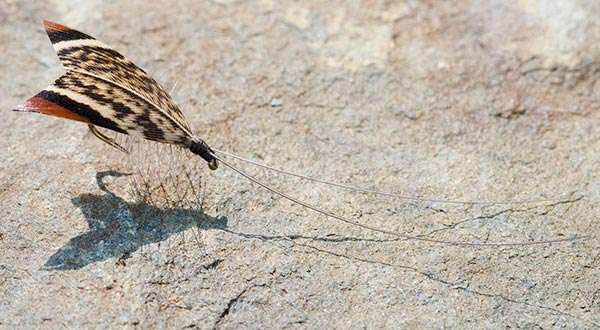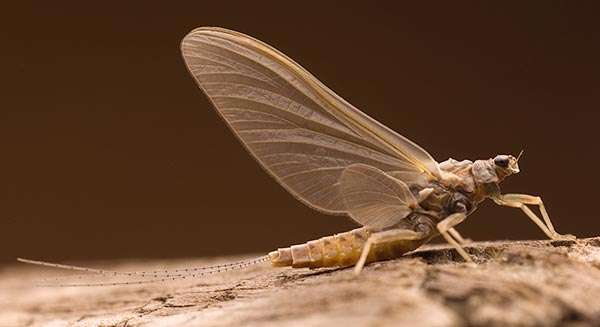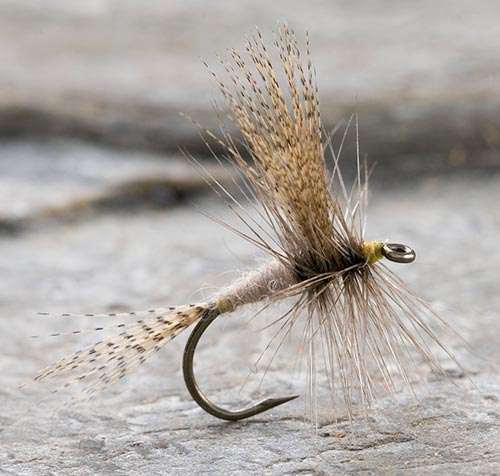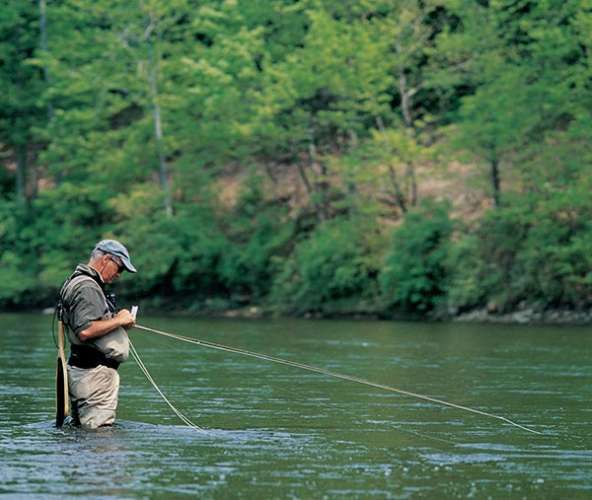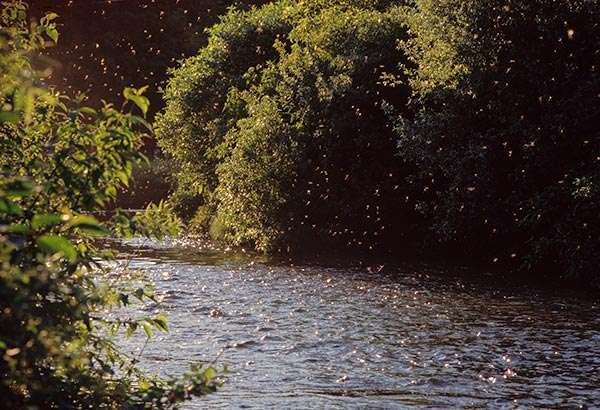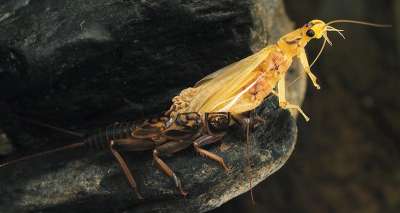
The evening was warm, even for August, and the pitcher for the home team Lowell Spinners was having trouble finding the plate. Millions of white mayflies, disoriented by the bright lights of the baseball stadium, had emerged from the nearby Merrimack River and swarmed over the field like a January blizzard, forcing the umpires to suspend the game. Insects courted and coupled in the air, then fell to the grass and into the seats, where the fertilized females discharged twin canisters of caustic, buttery-yellow eggs and then expired. Within 45 minutes the air had cleared, the grounds crew preened the field, and play continued.
The Spinners’ fans had just witnessed what fly-fishers know as a white fly “hatch.” Biologists call it an emergence of the Ephoron leukon mayfly. Mature larvae tunnel out of their burrows in the substrate – that variable composite of rocks, sand, silt, and organic material that lines the beds of rivers – and swim to the water’s surface. There, they cast off their larval casings, inflate their wings, and take to the air. The white fly’s adult flight period, brief even by mayfly standards, underscores the name of its order, Ephemeroptera. The males cast off a final membranous layer prior to coupling with the females. Ironically, the fly-fishers’ jargon for this mating form of a mayfly is spinner.
You can witness the same phenomenon by standing waist-deep in Connecticut’s Housatonic River at dusk in early August as you vainly try to attach a fly to your tippet without a flashlight. It would pass unnoticed were you to park your car at the side of U.S. Route 7 where it parallels the Housatonic only 10 yards away. When news of the white fly hatch spreads, dedicated fly-fishers change their evening plans and flock to the river.
At Home on the River
The rivers and streams that network through our northeastern woodlands include some of the most historic proving grounds of American fly-fishing. The Catskills rivers of the Delaware drainage, the placid lakes and roaring rivers of the Adirondacks, the limestone corridor of the Battenkill and Housatonic Rivers, and the fishing camps of western and central Maine all have their rich fly-fishing traditions. Each region provides an optimum and specialized aquatic habitat for a unique set of insects.
Most rivers begin under the canopy of forested hillsides, where leaf-shredding larvae chop up deciduous litter for food and shelter and send nutrients downstream in the form of smaller particles and their own waste. As rivulets collect into streams and then rivers, and sunlight reaches the substrate, light-loving plants and algae appear. Grazing, collecting, and predatory insects process an ever-richer food supply into increasingly finer particles. For each environmental niche along the way, an insect has evolved to exploit it.
Fly-fishers have created their own colorful nicknames for the most prevalent, “fishable” insects, along with artfully designed, hooked imitations. Among the many emergence and egglaying events by which fly-fishers set their calendars are the Hendrickson mayfly (Ephemerella subvaria), the green drake (Ephemera guttulata, known in its spinner form as the coffin fly), and the alder (Macrostemum zebratum, a caddis).
The prime opportunity for fly-fishers is “the hatch,” when aquatic insect larvae or pupae rise to the surface of water and transform into winged adults. Many of these bugs thrive in the same cold, fresh, oxygen-rich water that is home to the region’s salmonid fish, which include all species of salmon, trout, and char. The hatch is the golden moment when the survival strategies of aquatic insects and this family of freshwater fish synthesize to make fly-fishing possible. The conditions are often repeated when these same insects return to the water to lay their eggs.
Struggling to Emerge
The life cycle of an aquatic insect resembles that of a moth or butterfly. It can last from a few days to a few years, but for most the cycle is annual. An adult female lays eggs near, on, or under the water, and within days or weeks larvae crawl from the eggs. A larva has just one job: to gather all the energy it will need for the transformation to its adult form. For caddisflies, midges, and aquatic beetles, among others, metamorphosis is complete and passes through a cocooned pupal stage. For mayflies, stoneflies, and dragonflies, metamorphosis is incomplete; the winged adult or sub-adult climbs directly through a split in the larval exoskeleton. Many aquatic insects are sexually mature upon emergence. Some lack mouth parts for eating or drinking, and their adult lives last only minutes, hours, or days. Like the larva, the adult has a single mission, which is to return fertilized eggs to the larval habitat.
As aquatic larvae hunt or forage for food on the stream bottom, and compete for living space, the current inevitably carries them downstream. Without upstream flight, the entire insect fauna of a watershed would eventually wash out to sea. Many aquatic insects – including most of the mayflies, caddisflies, and midges so often imitated by fly anglers – emerge directly from the water as winged insects and return upstream to the habitat where the previous generation deposited its eggs and where the next generation is best adapted to thrive. Mayflies in the family Ephemerellidae, for example, avoid drowning by emerging on smooth surfaces. The fertilized female, however, lays her eggs upriver in choppy water over stony riffles where her sturdy, crawling offspring are most likely to prosper.
Mayflies are singular in emerging as sub-adults with an extra, water-resistant membrane. For centuries, fly fishers have called the newly hatched mayflies “duns,” based on the semiopaque, grayish appearance of their two pairs of wings. Male and female duns alike shed this final skin to prepare for aerial mating. The stripped-down adult has a sleek body supported by glassy, hyaline wings whose shimmer gives the appearance of an insect spinning in flight. Entomologists use the labels subimago and imago, respectively, to describe these sub-adult and sexually mature mayflies.
At the moment of transition to a winged adult, an insect is vulnerable to predators and to the shifting landscape of the currents. It can be a struggle to break through the surface tension and climb out of a pupal or larval skin. Many drown in the attempt. Others fall prey to fish of all kinds. Those that succeed in taking flight must escape the birds that swoop out of the sky to pick off newly hatched adults as they seek the safety of trees. To beat these long odds, insects of a single species emerge from the water and return later to lay eggs, in overwhelming numbers and at the same time. Each species has its appointed flight window on the yearly calendar with some variance according to geographic and meteorological conditions. Although insects emerge from the stream throughout the year, the succession of major, fishable hatches gets underway just as streamside shrubs and trees are leafing out in the spring and ends when the last autumn leaves have fallen. Emergence is a response to the right combination of heat energy and light, as if these factors were programmed into each species’ DNA. When the water has been warm enough for long enough, and enough light has reached the stream bottom for the correct number of hours, the hatch begins. Thousands of insects of the same species ascend to the water’s surface to become flying, air-breathing adults. A great many get eaten, but enough escape to perpetuate the species.
The spectacle repeats over a period of days at roughly the same hour until the entire species has run the gauntlet and the survivors are resting in the streamside foliage, preparing for the second half of their ordeal. Mayfly spinners mate over the water in mid-air. Caddisflies, stoneflies, and others mate at the water’s edge and in the privacy offered by trees and shrubs. Most will return to the water to lay eggs. This, too, is a synchronous event with a similar set of perils.
Insect Imitation
Salmonids have their own survival strategy of selective feeding. For much of the year they have foraged in the substrate or waited until hapless insect larvae pass by in the drift. A fish typically does not reflexively recognize food by sight, but it can taste-test for edibility and either swallow the object or spit it out. During the warmer months, when insects are active, salmonids concentrate their feeding on insect emergence and egg-laying events. Some intercept the nymphs – pharate or preemergent adults – as they swim to the surface. Others seize the moment of eclosion, when the insect is temporarily straight-jacketed by its shedding skin, to feed. With so many insects of a single species available during a hatch, a trout need not waste time with oral sampling. It instead keys on the characteristic size, shape, color, and behavior of the prevalent insect and eats nothing else. This guaranteed return on its energy investment offsets the risk of exposure to predators that a fish runs when it rises to the surface. If a trout can feed safely beneath the surface on ascending dark blue sedge (Psilotreta labida) caddisfly pupae, it may avoid rising to the much larger (and more nutritious) egg-laying coffin flies that litter the surface of the water.
For fly-fishers, these survival strategies complicate what might otherwise seem like a pretty straightforward proposition of presenting the right fly in the right way at the right time. An understanding of the rhythms and cycles of the season, combined with astute powers of observation, can make the difference between a satisfying evening on the stream and hours of frustration and disappointment. Mayflies of different genera, to offer one example, are more likely to share the same flight period than two distinct species of the same genus. If you arrive at the water during a sulfur mayfly hatch (Ephemerella dorothea) with a matching, size-18, bright yellow emerger pattern tied onto a gossamer 6X tippet, you may catch your limit of trout many times over. (Of course, you will comply with regulations by gently releasing them.) If your pattern is a size too large, or a shade too brown, or doesn’t sit just right on the water, you might wish you had stayed home.
The exact timing of emergence varies with both latitude and altitude. Spring arrives sooner in southern states and at lower elevations, as the degree-days accumulate more rapidly. The advantage is slightly offset by the greater number of daylight hours in the farther north at midsummer. As a result, the season of greatest insect activity compresses, and the density of the insect hatches increases as one travels farther north.
Even within New England, the calendar can shift dramatically. The Hendrickson mayfly that swarms over the Housatonic River in mid- to late-April waits until early June to appear over the Kennebec in Maine. A few naturalists have attempted to account for these regional differences by correlating the emergence of particular insect species with the flowering of local plants. Whether or not such pairings of flora and fauna are consistent from one locale to another, I have noticed that when the Hendrickson mayflies first appear, the honeysuckle shrubs along the riverbanks are beginning to leaf out. The dark blue sedge swarms when maple leaves shift from the yellow-greens of spring to the blue-greens of midsummer, and the pumpkin caddis (Pycnopsyche) starts gathering under my porch light just as the same maples exhibit the first reddish hues of autumn.
If you are a fly-fisher, there are few greater pleasures than connecting to a fish with your hand-tied counterfeit fly, but you need not take up the sport to experience the thrill of the hatch. I have witnessed clouds of Brachycentrus caddisflies backlit by the setting sun over New Hampshire’s Pemigewasset River, and sat in stunned silence on the shores of Vermont’s Black River to stare at wave after wave of dark blue sedges rushing upstream. Under a hailstorm of coffin flies descending from the towering trees above Tamarack Stream, I’ve caught the insects with a net instead of the rising fish with my fly rod. I’ve watched in wonder when a swarm of golden stoneflies darkened the evening skies over the upper Connecticut, and I’ve driven through a downpour of dying Hexagenia mayflies along the shores of Cape Breton’s Lake Ainslee. At times like these I am reminded that the prospect of catching a fish is often what draws me to the water, but it is rarely the only reason that I am there.


